Leadership & Change Management: General Motors Case Study Analysis
VerifiedAdded on 2023/04/24
|6
|1603
|153
Case Study
AI Summary
This case study examines General Motors' organizational change management strategies in response to competitive pressures from Japanese automakers like Toyota. The analysis focuses on the internal reasons compelling change, such as high labor costs, and the implemented structural, cost, process, and cultural changes. The company faced challenges, including resistance from trade unions regarding wage cuts and a lack of employee involvement in the change process due to autocratic leadership. While strategic changes helped regain market position and reduce costs, better communication and employee engagement could have accelerated the company's recovery. The study highlights the importance of leadership strategies, employee engagement, and effective communication in successful change management, while also acknowledging the negative impact of employee attrition. The author reflects on their internship experience at General Motors, emphasizing the practical application of change management theories and the importance of preparing for and adapting to change in organizations. The case underscores the need for firms to invest in people, processes, and performance while valuing diverse opinions during organizational transitions.
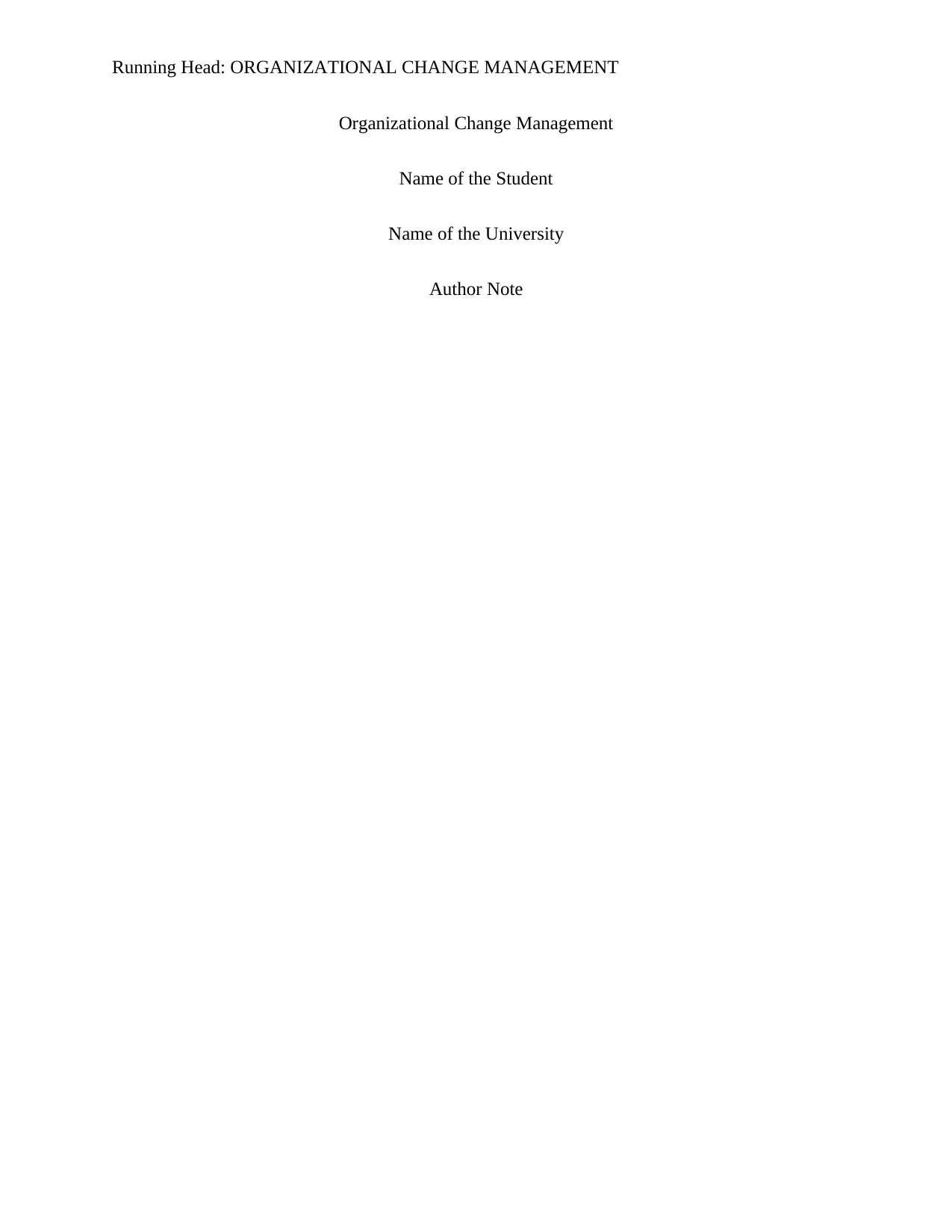
Running Head: ORGANIZATIONAL CHANGE MANAGEMENT
Organizational Change Management
Name of the Student
Name of the University
Author Note
Organizational Change Management
Name of the Student
Name of the University
Author Note
Paraphrase This Document
Need a fresh take? Get an instant paraphrase of this document with our AI Paraphraser
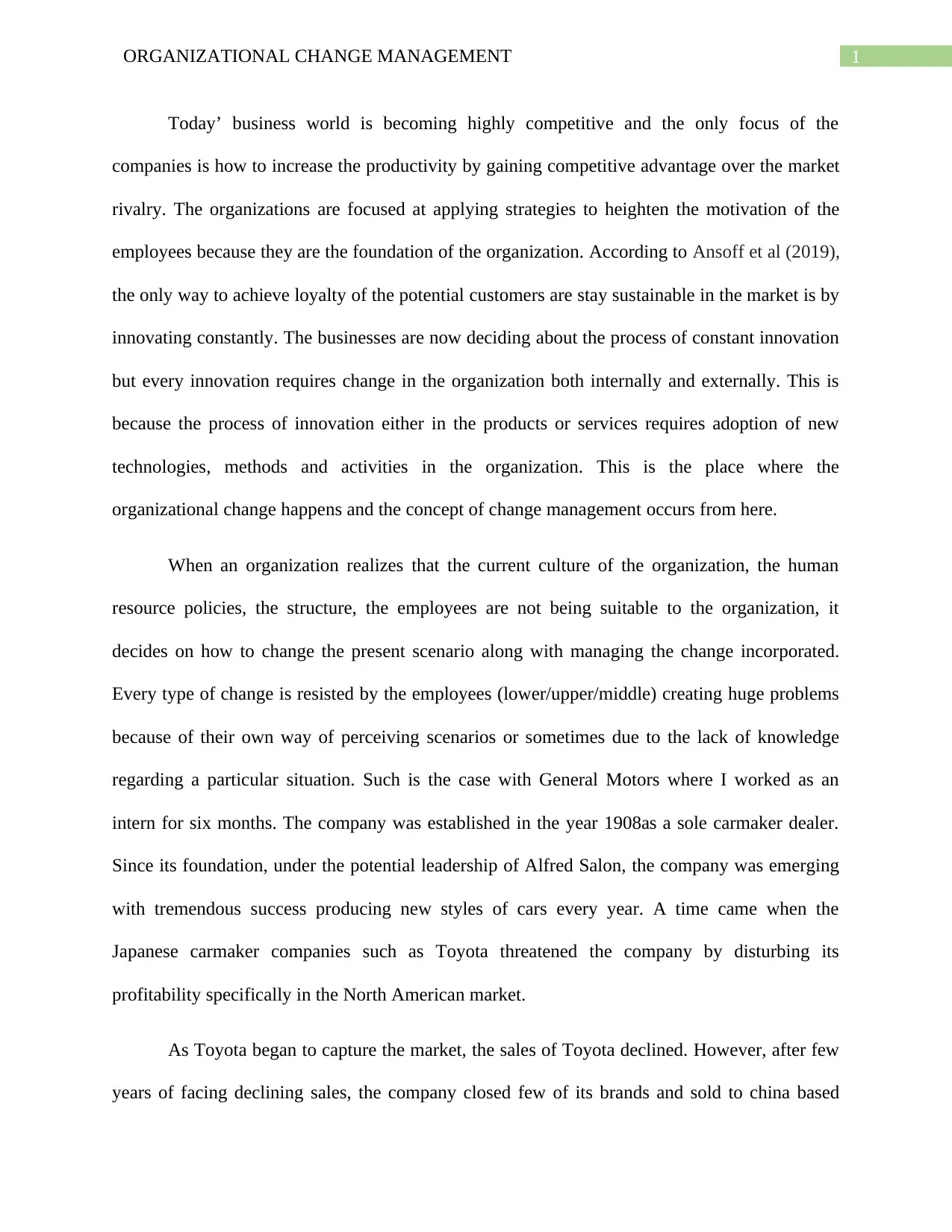
1ORGANIZATIONAL CHANGE MANAGEMENT
Today’ business world is becoming highly competitive and the only focus of the
companies is how to increase the productivity by gaining competitive advantage over the market
rivalry. The organizations are focused at applying strategies to heighten the motivation of the
employees because they are the foundation of the organization. According to Ansoff et al (2019),
the only way to achieve loyalty of the potential customers are stay sustainable in the market is by
innovating constantly. The businesses are now deciding about the process of constant innovation
but every innovation requires change in the organization both internally and externally. This is
because the process of innovation either in the products or services requires adoption of new
technologies, methods and activities in the organization. This is the place where the
organizational change happens and the concept of change management occurs from here.
When an organization realizes that the current culture of the organization, the human
resource policies, the structure, the employees are not being suitable to the organization, it
decides on how to change the present scenario along with managing the change incorporated.
Every type of change is resisted by the employees (lower/upper/middle) creating huge problems
because of their own way of perceiving scenarios or sometimes due to the lack of knowledge
regarding a particular situation. Such is the case with General Motors where I worked as an
intern for six months. The company was established in the year 1908as a sole carmaker dealer.
Since its foundation, under the potential leadership of Alfred Salon, the company was emerging
with tremendous success producing new styles of cars every year. A time came when the
Japanese carmaker companies such as Toyota threatened the company by disturbing its
profitability specifically in the North American market.
As Toyota began to capture the market, the sales of Toyota declined. However, after few
years of facing declining sales, the company closed few of its brands and sold to china based
Today’ business world is becoming highly competitive and the only focus of the
companies is how to increase the productivity by gaining competitive advantage over the market
rivalry. The organizations are focused at applying strategies to heighten the motivation of the
employees because they are the foundation of the organization. According to Ansoff et al (2019),
the only way to achieve loyalty of the potential customers are stay sustainable in the market is by
innovating constantly. The businesses are now deciding about the process of constant innovation
but every innovation requires change in the organization both internally and externally. This is
because the process of innovation either in the products or services requires adoption of new
technologies, methods and activities in the organization. This is the place where the
organizational change happens and the concept of change management occurs from here.
When an organization realizes that the current culture of the organization, the human
resource policies, the structure, the employees are not being suitable to the organization, it
decides on how to change the present scenario along with managing the change incorporated.
Every type of change is resisted by the employees (lower/upper/middle) creating huge problems
because of their own way of perceiving scenarios or sometimes due to the lack of knowledge
regarding a particular situation. Such is the case with General Motors where I worked as an
intern for six months. The company was established in the year 1908as a sole carmaker dealer.
Since its foundation, under the potential leadership of Alfred Salon, the company was emerging
with tremendous success producing new styles of cars every year. A time came when the
Japanese carmaker companies such as Toyota threatened the company by disturbing its
profitability specifically in the North American market.
As Toyota began to capture the market, the sales of Toyota declined. However, after few
years of facing declining sales, the company closed few of its brands and sold to china based
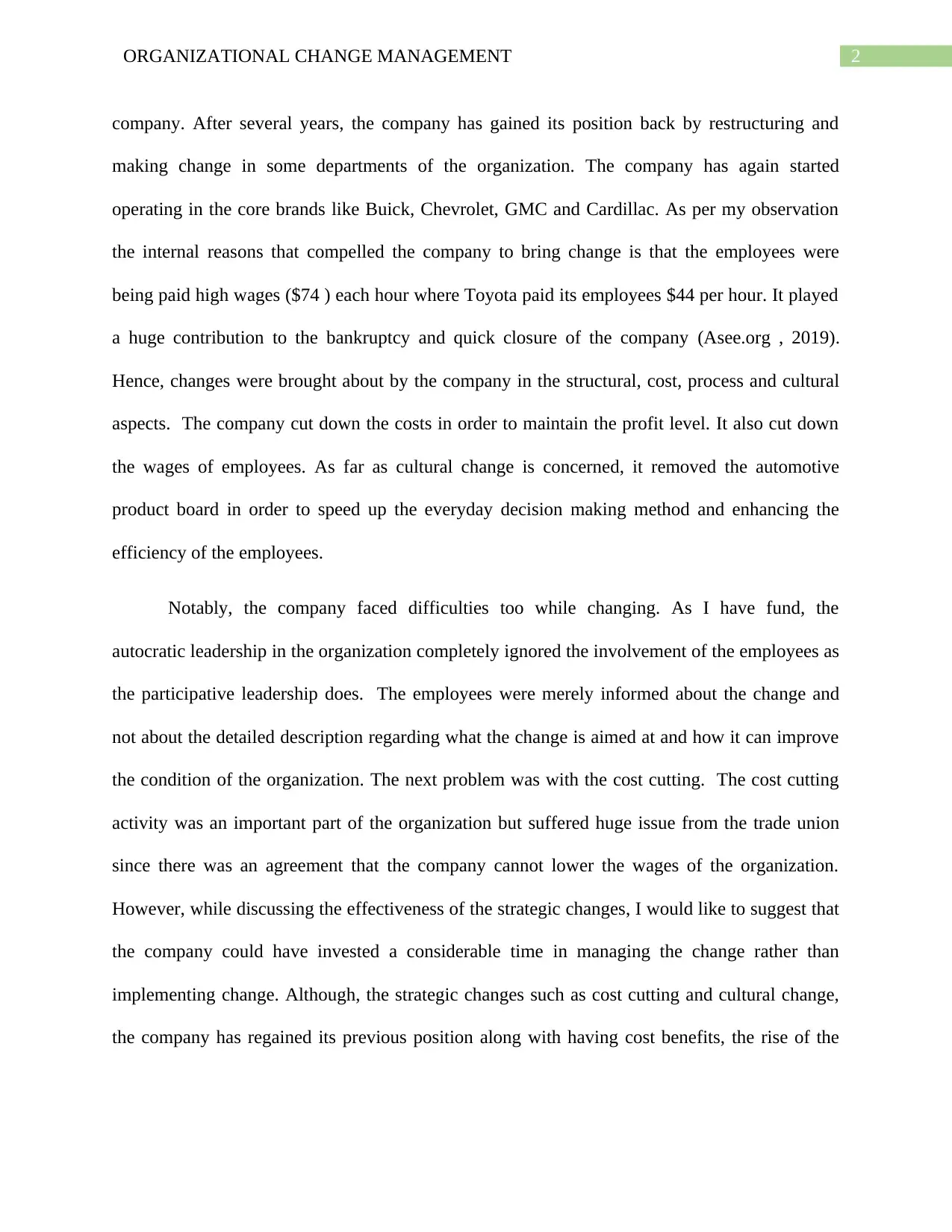
2ORGANIZATIONAL CHANGE MANAGEMENT
company. After several years, the company has gained its position back by restructuring and
making change in some departments of the organization. The company has again started
operating in the core brands like Buick, Chevrolet, GMC and Cardillac. As per my observation
the internal reasons that compelled the company to bring change is that the employees were
being paid high wages ($74 ) each hour where Toyota paid its employees $44 per hour. It played
a huge contribution to the bankruptcy and quick closure of the company (Asee.org , 2019).
Hence, changes were brought about by the company in the structural, cost, process and cultural
aspects. The company cut down the costs in order to maintain the profit level. It also cut down
the wages of employees. As far as cultural change is concerned, it removed the automotive
product board in order to speed up the everyday decision making method and enhancing the
efficiency of the employees.
Notably, the company faced difficulties too while changing. As I have fund, the
autocratic leadership in the organization completely ignored the involvement of the employees as
the participative leadership does. The employees were merely informed about the change and
not about the detailed description regarding what the change is aimed at and how it can improve
the condition of the organization. The next problem was with the cost cutting. The cost cutting
activity was an important part of the organization but suffered huge issue from the trade union
since there was an agreement that the company cannot lower the wages of the organization.
However, while discussing the effectiveness of the strategic changes, I would like to suggest that
the company could have invested a considerable time in managing the change rather than
implementing change. Although, the strategic changes such as cost cutting and cultural change,
the company has regained its previous position along with having cost benefits, the rise of the
company. After several years, the company has gained its position back by restructuring and
making change in some departments of the organization. The company has again started
operating in the core brands like Buick, Chevrolet, GMC and Cardillac. As per my observation
the internal reasons that compelled the company to bring change is that the employees were
being paid high wages ($74 ) each hour where Toyota paid its employees $44 per hour. It played
a huge contribution to the bankruptcy and quick closure of the company (Asee.org , 2019).
Hence, changes were brought about by the company in the structural, cost, process and cultural
aspects. The company cut down the costs in order to maintain the profit level. It also cut down
the wages of employees. As far as cultural change is concerned, it removed the automotive
product board in order to speed up the everyday decision making method and enhancing the
efficiency of the employees.
Notably, the company faced difficulties too while changing. As I have fund, the
autocratic leadership in the organization completely ignored the involvement of the employees as
the participative leadership does. The employees were merely informed about the change and
not about the detailed description regarding what the change is aimed at and how it can improve
the condition of the organization. The next problem was with the cost cutting. The cost cutting
activity was an important part of the organization but suffered huge issue from the trade union
since there was an agreement that the company cannot lower the wages of the organization.
However, while discussing the effectiveness of the strategic changes, I would like to suggest that
the company could have invested a considerable time in managing the change rather than
implementing change. Although, the strategic changes such as cost cutting and cultural change,
the company has regained its previous position along with having cost benefits, the rise of the
⊘ This is a preview!⊘
Do you want full access?
Subscribe today to unlock all pages.

Trusted by 1+ million students worldwide
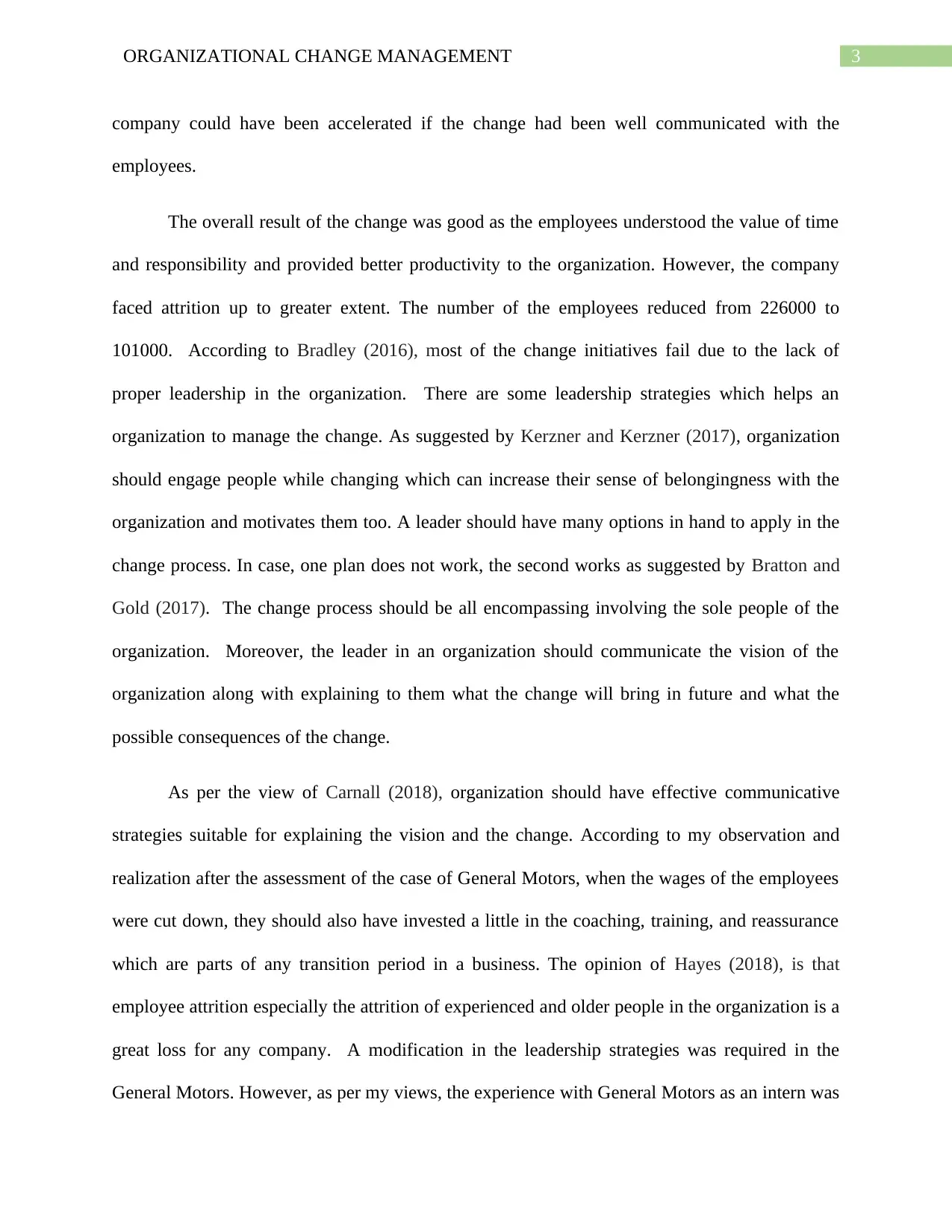
3ORGANIZATIONAL CHANGE MANAGEMENT
company could have been accelerated if the change had been well communicated with the
employees.
The overall result of the change was good as the employees understood the value of time
and responsibility and provided better productivity to the organization. However, the company
faced attrition up to greater extent. The number of the employees reduced from 226000 to
101000. According to Bradley (2016), most of the change initiatives fail due to the lack of
proper leadership in the organization. There are some leadership strategies which helps an
organization to manage the change. As suggested by Kerzner and Kerzner (2017), organization
should engage people while changing which can increase their sense of belongingness with the
organization and motivates them too. A leader should have many options in hand to apply in the
change process. In case, one plan does not work, the second works as suggested by Bratton and
Gold (2017). The change process should be all encompassing involving the sole people of the
organization. Moreover, the leader in an organization should communicate the vision of the
organization along with explaining to them what the change will bring in future and what the
possible consequences of the change.
As per the view of Carnall (2018), organization should have effective communicative
strategies suitable for explaining the vision and the change. According to my observation and
realization after the assessment of the case of General Motors, when the wages of the employees
were cut down, they should also have invested a little in the coaching, training, and reassurance
which are parts of any transition period in a business. The opinion of Hayes (2018), is that
employee attrition especially the attrition of experienced and older people in the organization is a
great loss for any company. A modification in the leadership strategies was required in the
General Motors. However, as per my views, the experience with General Motors as an intern was
company could have been accelerated if the change had been well communicated with the
employees.
The overall result of the change was good as the employees understood the value of time
and responsibility and provided better productivity to the organization. However, the company
faced attrition up to greater extent. The number of the employees reduced from 226000 to
101000. According to Bradley (2016), most of the change initiatives fail due to the lack of
proper leadership in the organization. There are some leadership strategies which helps an
organization to manage the change. As suggested by Kerzner and Kerzner (2017), organization
should engage people while changing which can increase their sense of belongingness with the
organization and motivates them too. A leader should have many options in hand to apply in the
change process. In case, one plan does not work, the second works as suggested by Bratton and
Gold (2017). The change process should be all encompassing involving the sole people of the
organization. Moreover, the leader in an organization should communicate the vision of the
organization along with explaining to them what the change will bring in future and what the
possible consequences of the change.
As per the view of Carnall (2018), organization should have effective communicative
strategies suitable for explaining the vision and the change. According to my observation and
realization after the assessment of the case of General Motors, when the wages of the employees
were cut down, they should also have invested a little in the coaching, training, and reassurance
which are parts of any transition period in a business. The opinion of Hayes (2018), is that
employee attrition especially the attrition of experienced and older people in the organization is a
great loss for any company. A modification in the leadership strategies was required in the
General Motors. However, as per my views, the experience with General Motors as an intern was
Paraphrase This Document
Need a fresh take? Get an instant paraphrase of this document with our AI Paraphraser
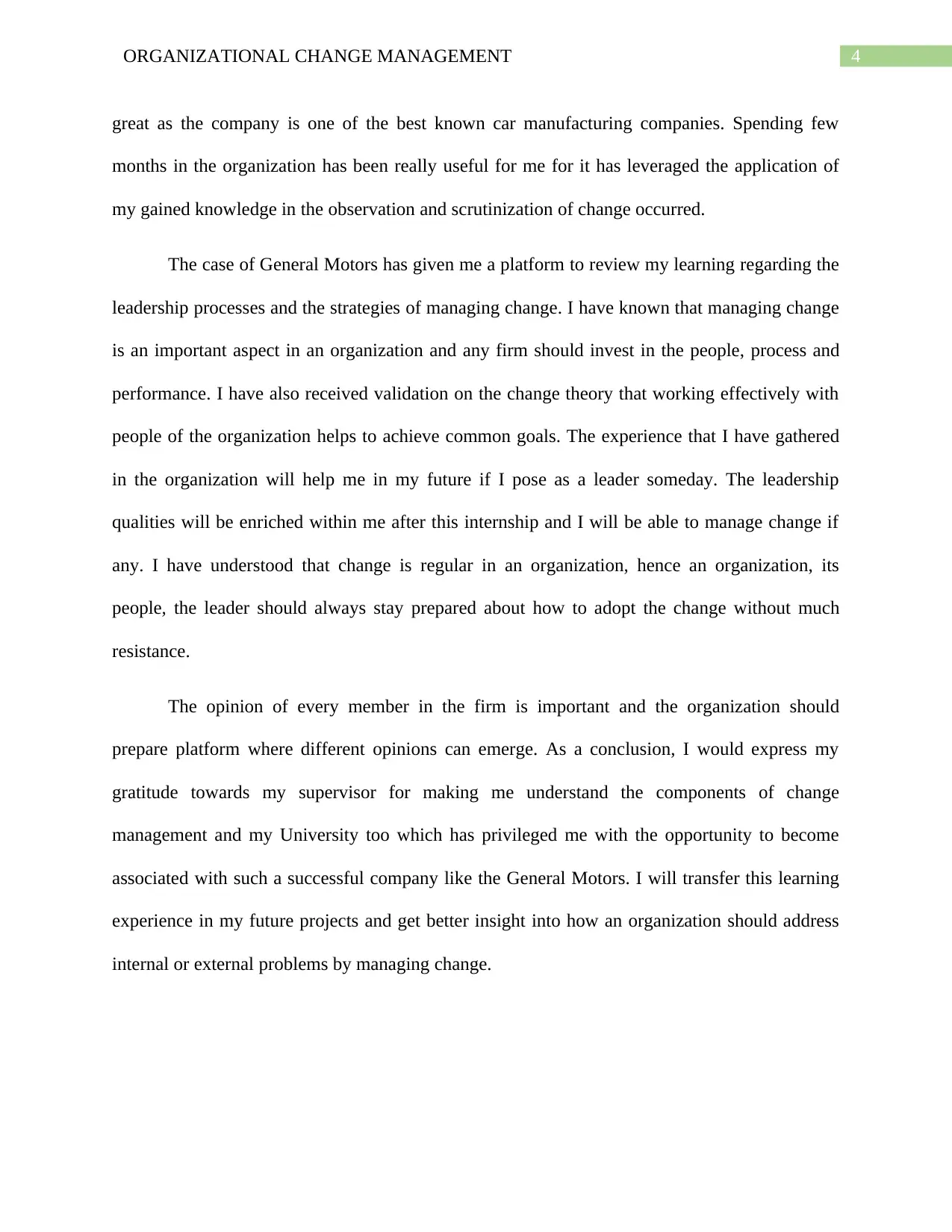
4ORGANIZATIONAL CHANGE MANAGEMENT
great as the company is one of the best known car manufacturing companies. Spending few
months in the organization has been really useful for me for it has leveraged the application of
my gained knowledge in the observation and scrutinization of change occurred.
The case of General Motors has given me a platform to review my learning regarding the
leadership processes and the strategies of managing change. I have known that managing change
is an important aspect in an organization and any firm should invest in the people, process and
performance. I have also received validation on the change theory that working effectively with
people of the organization helps to achieve common goals. The experience that I have gathered
in the organization will help me in my future if I pose as a leader someday. The leadership
qualities will be enriched within me after this internship and I will be able to manage change if
any. I have understood that change is regular in an organization, hence an organization, its
people, the leader should always stay prepared about how to adopt the change without much
resistance.
The opinion of every member in the firm is important and the organization should
prepare platform where different opinions can emerge. As a conclusion, I would express my
gratitude towards my supervisor for making me understand the components of change
management and my University too which has privileged me with the opportunity to become
associated with such a successful company like the General Motors. I will transfer this learning
experience in my future projects and get better insight into how an organization should address
internal or external problems by managing change.
great as the company is one of the best known car manufacturing companies. Spending few
months in the organization has been really useful for me for it has leveraged the application of
my gained knowledge in the observation and scrutinization of change occurred.
The case of General Motors has given me a platform to review my learning regarding the
leadership processes and the strategies of managing change. I have known that managing change
is an important aspect in an organization and any firm should invest in the people, process and
performance. I have also received validation on the change theory that working effectively with
people of the organization helps to achieve common goals. The experience that I have gathered
in the organization will help me in my future if I pose as a leader someday. The leadership
qualities will be enriched within me after this internship and I will be able to manage change if
any. I have understood that change is regular in an organization, hence an organization, its
people, the leader should always stay prepared about how to adopt the change without much
resistance.
The opinion of every member in the firm is important and the organization should
prepare platform where different opinions can emerge. As a conclusion, I would express my
gratitude towards my supervisor for making me understand the components of change
management and my University too which has privileged me with the opportunity to become
associated with such a successful company like the General Motors. I will transfer this learning
experience in my future projects and get better insight into how an organization should address
internal or external problems by managing change.
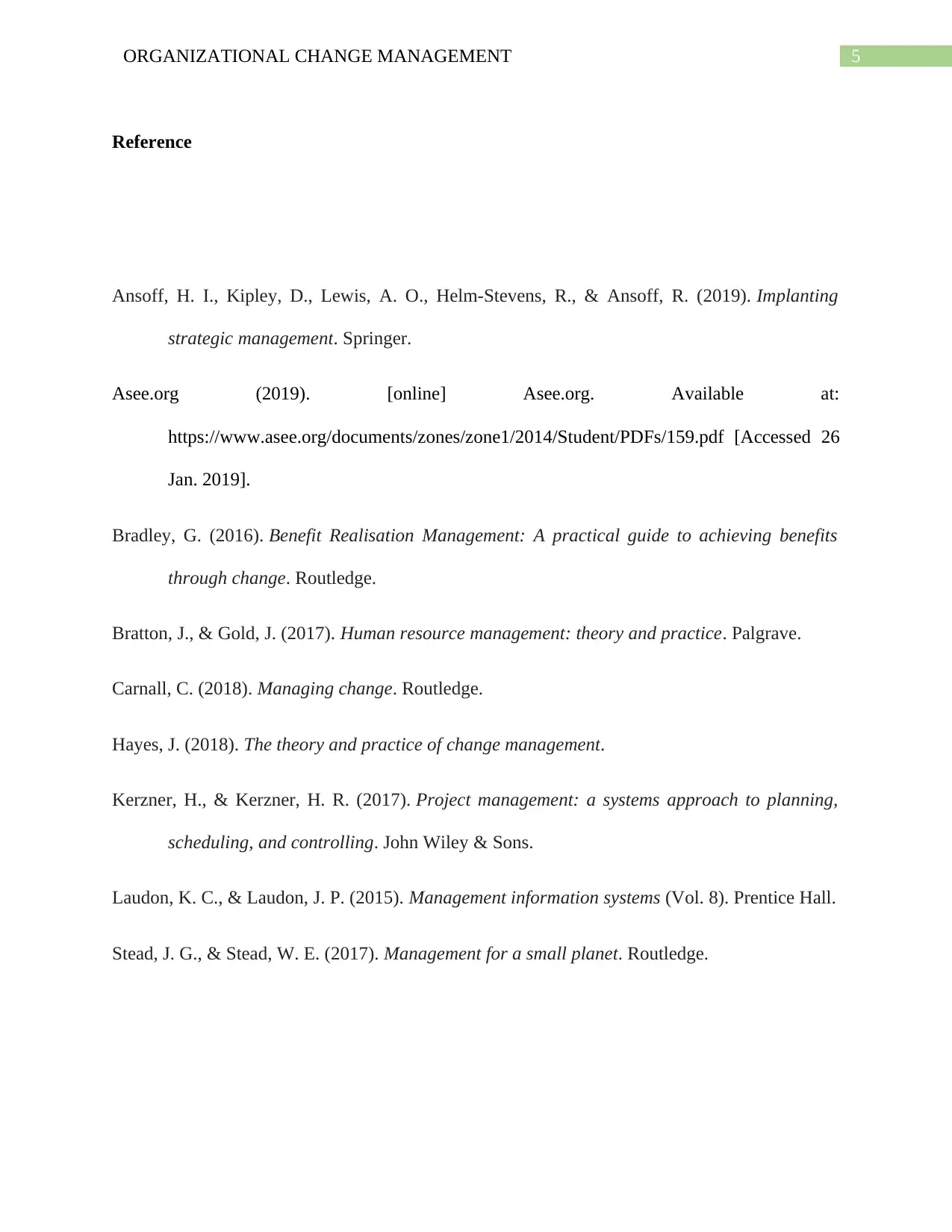
5ORGANIZATIONAL CHANGE MANAGEMENT
Reference
Ansoff, H. I., Kipley, D., Lewis, A. O., Helm-Stevens, R., & Ansoff, R. (2019). Implanting
strategic management. Springer.
Asee.org (2019). [online] Asee.org. Available at:
https://www.asee.org/documents/zones/zone1/2014/Student/PDFs/159.pdf [Accessed 26
Jan. 2019].
Bradley, G. (2016). Benefit Realisation Management: A practical guide to achieving benefits
through change. Routledge.
Bratton, J., & Gold, J. (2017). Human resource management: theory and practice. Palgrave.
Carnall, C. (2018). Managing change. Routledge.
Hayes, J. (2018). The theory and practice of change management.
Kerzner, H., & Kerzner, H. R. (2017). Project management: a systems approach to planning,
scheduling, and controlling. John Wiley & Sons.
Laudon, K. C., & Laudon, J. P. (2015). Management information systems (Vol. 8). Prentice Hall.
Stead, J. G., & Stead, W. E. (2017). Management for a small planet. Routledge.
Reference
Ansoff, H. I., Kipley, D., Lewis, A. O., Helm-Stevens, R., & Ansoff, R. (2019). Implanting
strategic management. Springer.
Asee.org (2019). [online] Asee.org. Available at:
https://www.asee.org/documents/zones/zone1/2014/Student/PDFs/159.pdf [Accessed 26
Jan. 2019].
Bradley, G. (2016). Benefit Realisation Management: A practical guide to achieving benefits
through change. Routledge.
Bratton, J., & Gold, J. (2017). Human resource management: theory and practice. Palgrave.
Carnall, C. (2018). Managing change. Routledge.
Hayes, J. (2018). The theory and practice of change management.
Kerzner, H., & Kerzner, H. R. (2017). Project management: a systems approach to planning,
scheduling, and controlling. John Wiley & Sons.
Laudon, K. C., & Laudon, J. P. (2015). Management information systems (Vol. 8). Prentice Hall.
Stead, J. G., & Stead, W. E. (2017). Management for a small planet. Routledge.
⊘ This is a preview!⊘
Do you want full access?
Subscribe today to unlock all pages.

Trusted by 1+ million students worldwide
1 out of 6
Related Documents
Your All-in-One AI-Powered Toolkit for Academic Success.
+13062052269
info@desklib.com
Available 24*7 on WhatsApp / Email
![[object Object]](/_next/static/media/star-bottom.7253800d.svg)
Unlock your academic potential
Copyright © 2020–2025 A2Z Services. All Rights Reserved. Developed and managed by ZUCOL.





